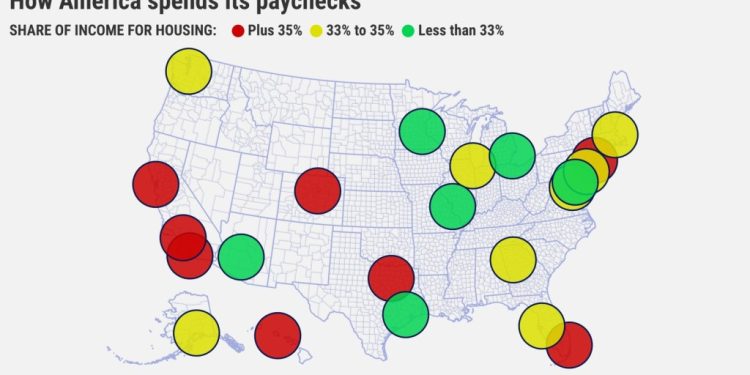California is an expensive place to live, but the way money is spent is not universal.
My faithful calculation sheet has examined the curious consumption data created by the Bureau of Labor Statistics. These statistics follow household demography and average consumption expenses in 2022 and 2023 in the 22 American regions – including three in California.
These figures give us an overview of the place where the dollars of a family go and how it differs according to geography. And it is not a flash of information that the Californians do more than the typical American.
According to this calculation, the average annual income of households before taxes was $ 154,992 for the bay region, $ 124,346 in the region surrounding Los Angeles and $ 122,832 in San Diego. At the national level, it’s $ 97,911.
However, note a significant difference in the number of pay checks necessary to create this family cash flow. Consign that around 50% of households around have two employees, 40% in San Diego and 30% in San Francisco and on a national level.
This high income is a key reason why Californians can spend more than the typical American.
The report indicates that typical expenses cost $ 110,886 per year in the bay region in 2022-23, $ 91,204 in San Diego and $ 86,077 around the $ 75,172 nationally. The report did not offer any local detail on the difference between what is won and what is spent – but it is probably taxes and savings.
The most intriguing theme of these figures was the way households went differently through geography.
Eat outside
Think of the different slices of household expenditure.
It is not surprising that the accommodation takes a big bite of the invoices of the Californians. It represents 38% of total spending in the Bay region and San Diego, and 37% in Los Angeles nationwide, it’s only 33%.
But this is how the Californians spend outside of housing costs which testify to various lifestyles through the state.
First, consider food spending. It does not vary much geographically because it represents 14% of total spending around Los Angeles and 13% in the Bay region, San Diego and at the national level.
Where there is an interesting ditch is how much we go to eat. Around Los Angeles, it is 48% of food costs, but only 44% in the bay region and 39% in San Diego and nationally.
Could family size influence this? There are 2.7 people in a typical household of the counter 2.5 in San Diego, the 2.3 and 2.4 of the Bay Area.
Add to that the many households with two incomes around Los Angeles, and you see why they are OK let someone else cook.
Which motivates expenses
Then take a look at dollar contrasts for transportation. It is only 14% of consumer spending in the bay region against 16% around and San Diego and 17% nationally.
Is the gap due to urban life and the Bay Area public transport system? “Public and other transport,” totals 14% of transport costs in the bay region against 10% in San Diego, 9% around and 8% on a national level.
Or could it seem to be possession of the car? The typical cleaning of the Bay region has only 1.6 vehicles against 1.8 around and San Diego and 1.9 on a national scale.
Healthy expenses
A little good news in the report show that health spending is a modest part of the California common budget.
Staying healthy represented 6% of spending on the three Californian markets – well below 8% of the country.
While everyone complains about Doctor Bills, California is known as one of the cheapest states for medical care.
What is in your portfolio?
Regarding discretionary expenses, the Californians seem to be economical.
The Californians do not spend much for fun. Entertainment represents 4.2% of San Diego spending, 3.9% around Los Angeles and 3.4% in the Bay region. Those who drag the 4.7% of the country.
Is it because there is a good free weather and so much natural beauty?
And what is described as “cash contributions” – donations to others such as charity, alimony or child alimony – represent only 1.7% of expenses around, 2.5% in San Diego and 3.5% in the Bay region. Nationally? 3.4%.
Maybe the Californians have little after paying the necessities of life.
Jonathan Lansner is company columnist for Southern California News Group. It can be attached to jlansner@scng.com
California Daily Newspapers


